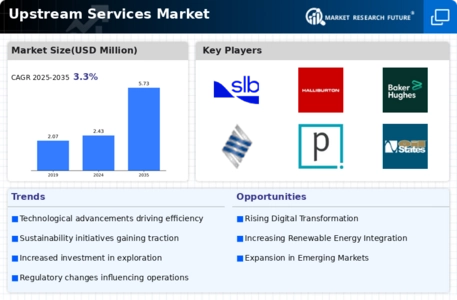Market Trends
Key Emerging Trends in the Upstream Services Market
The Upstream Services market is a dynamic sector with activities revolving around exploration, drilling as well as production of oil and gas; where companies have adopted different market share positioning strategies to succeed in this competitive environment. Differentiation emerges as one of such strategies whereby firms aim at distinguishing what they offer upstream from other providers. This can involve providing unique reservoir management expertise, advanced drilling technologies or sophisticated proprietary exploration methods. To attract specialized and efficient solutions needed in exploration and production phases of oil &gas operators seeking for oil field services with distinct attributes. Cost leadership is another pivotal strategy in the Upstream Services market. Some companies focus on optimizing operational efficiency, utilizing cost-effective technologies, and achieving economies of scale to be able to offer services at an affordable price. In cases where costs play a vital role when selecting service providers for oil & gas operators, this approach is preferable. Cheap and reliable upstream services are offered by these firms so that they can expand their customer base while gaining competitive advantage over competitors in markets that take into account prices during decision-making about which company should carry out exploration or produce hydrocarbons.
In the upstream services sector, innovation is critical to gaining market share. Research and Development investments are made by companies to bring in new technologies including digital oilfield solutions, artificial intelligence for reservoir modelling or environmentally sustainable drilling practices. Staying at the forefront of technological advancements not only meets evolving customer needs but also positions companies as leaders in upstream exploration and production. This attracts oil and gas operators looking for state-of-the-art upstream services that align with the latest advancements in the energy industry. Collaboration and partnerships represent a strategic approach in the Upstream Services market. Establishing alliances with oil and gas exploration companies, drilling contractors, or other stakeholders in the energy sector can create synergies and expand market reach. Companies integrating their upstream services into broader energy ecosystem collaborating with key players within an industry can improve their visibility on a market significantly. This strategy is particularly effective in markets where seamless integration into existing exploration and production processes, collaboration with reputable industry partners are critical factors influencing adoption decisions.










Leave a Comment